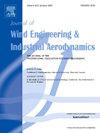组合式风障对桥梁上列车运行安全的影响
IF 4.9
2区 工程技术
Q1 ENGINEERING, CIVIL
Journal of Wind Engineering and Industrial Aerodynamics
Pub Date : 2025-09-12
DOI:10.1016/j.jweia.2025.106236
引用次数: 0
摘要
确保高速列车在桥上的运行安全至关重要,然而侧风经常给它们的安全通行带来重大风险。风障是提高列车在侧风条件下行车安全性的有效措施。本研究提出了一种结合了篱笆式风障和开孔式风障结构特点的组合式风障。以某大型悬索桥为研究对象,进行了一系列大型截面模型风洞试验。这些试验评估了三种WB类型对列车-桥梁系统(TBS)的空气动力学影响:OWB、FWB和CWB。在此基础上,利用自定义程序建立了风-车-桥耦合振动系统的三维解析模型,以评估其动力响应。对CWB的防风效果进行了对比分析,重点研究了TBS的气动性能和动力响应特性。研究结果显示,与平架桥和平架桥相比,绕道改善了列车在桥上的行车安全。绕道配置可最大降低峰值脱轨系数23.07%,最大降低峰值轮载率17.39%。此外,横摇对列车气动系数的影响主要决定了TBS的最大动力响应。在对空气动力性能和动力反应进行全面评估后,我们认为建议采用绕道,因为绕道的遮蔽效果更佳。本文章由计算机程序翻译,如有差异,请以英文原文为准。
Effects of combined-type wind barriers on the running safety of trains on bridges
Ensuring the operational safety of high-speed trains on bridges is critically important, yet crosswinds frequently present substantial risks to their safe passage. Wind barriers (WBs) serve as an effective measure to enhance the safety of trains operating on bridges under crosswind conditions. This study introduced a combined-type wind barrier (CWB) that combines the structural features of both fence-type wind barriers (FWBs) and open hole-type wind barriers (OWBs). A series of sectional model wind tunnel tests (WTTs) was conducted on a large scale, focusing on a wide suspension bridge. These tests assessed the aerodynamic effects of three WB types on the train-bridge system (TBS): OWB, FWB, and CWB. Based on these experimental results, a three-dimensional analytical model of the wind-train-bridge coupled vibration system was developed using a custom procedure to evaluate its dynamic response. A comparative analysis of the windproofing effectiveness of the CWB was conducted, focusing on the aerodynamic performance and dynamic response characteristics of the TBS. The outcomes highlight that CWB improves the running safety of trains on bridges, in comparison with both OWB and FWB. Maximum reductions of 23.07 % in peak derailment coefficient and 17.39 % in peak wheel load (WhL) reduction rate were achieved by the CWB configuration, respectively. Furthermore, the maximum dynamic response of the TBS is primarily determined by the WB effect on train aerodynamic coefficients. Following a comprehensive evaluation of aerodynamic performance and dynamic response, it has been realized that the adoption of the CWB is recommended due to its superior sheltering effectiveness.
求助全文
通过发布文献求助,成功后即可免费获取论文全文。
去求助
来源期刊
CiteScore
8.90
自引率
22.90%
发文量
306
审稿时长
4.4 months
期刊介绍:
The objective of the journal is to provide a means for the publication and interchange of information, on an international basis, on all those aspects of wind engineering that are included in the activities of the International Association for Wind Engineering http://www.iawe.org/. These are: social and economic impact of wind effects; wind characteristics and structure, local wind environments, wind loads and structural response, diffusion, pollutant dispersion and matter transport, wind effects on building heat loss and ventilation, wind effects on transport systems, aerodynamic aspects of wind energy generation, and codification of wind effects.
Papers on these subjects describing full-scale measurements, wind-tunnel simulation studies, computational or theoretical methods are published, as well as papers dealing with the development of techniques and apparatus for wind engineering experiments.

 求助内容:
求助内容: 应助结果提醒方式:
应助结果提醒方式:


